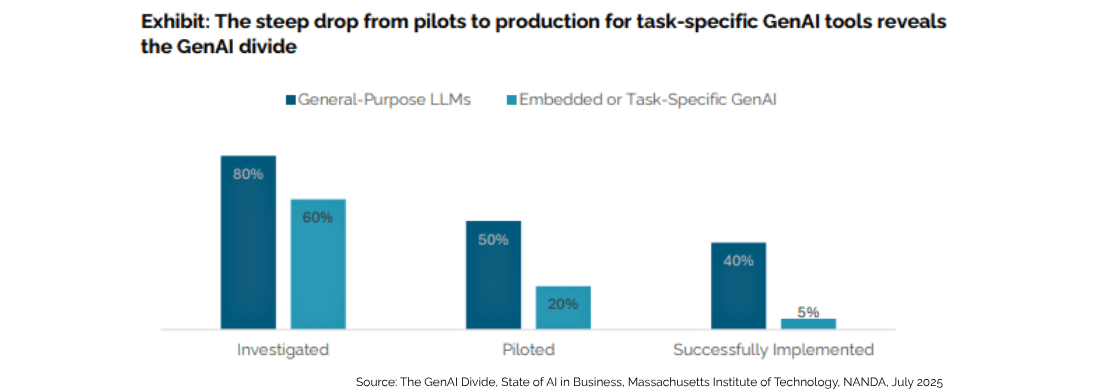From Hype to P&L: How to Ensure ROI on GenAI
Most organizations approaching GenAI face the same paradox: the technology is proven, the use cases are compelling, but the ROI remains elusive. MIT research shows 95% of enterprise GenAI projects, representing $30-40 billion in investment, are not delivering measurable returns1. The gap isn't technical—it's strategic. And it's solvable.
Before you wrap up another pilot or shelve another proof of concept, consider that the problem may not be the technology, but how companies deploy it. There's a better path forward, and it doesn’t start with the AI itself, but with the foundation beneath it.
Why the AI Promise Is Breaking
AI limitations are well documented and include hallucinations, bias, and accuracy challenges. But those technical issues aren't why 95% of organizations’ AI projects fail. The real breakdown happens when organizations deploy GenAI without addressing poor data quality, escalating costs, and unclear business value.
Here’s the disconnect: Too many organizations are chasing pilots without process foundation. They're selecting AI models before defining the processes those models need to support. They're choosing vendors before understanding the business outcomes they need to achieve. This technology-first thinking creates a fundamental disconnect: the focus shifts to what the AI can do rather than what your business needs it to do.
The result is impressive demos that don’t scale. Pilots that never transition to production. AI capabilities that don't translate to P&L impact.
The Power of Technology-Agnostic Design
Here's what the data tells us: purchasing AI tools from specialized vendors and building partnerships succeed about 67% of the time, while internal builds succeed only one-third as often2. But success isn't just about buy versus build—it's about how you architect your approach.
Building AI strategies around specific vendors or models can feel like the fastest path forward. In reality, it often becomes a constraint, especially with limited transparency. When your processes are tightly coupled to a particular AI technology, you inherit both its strengths and its limitations. More importantly, you lose the flexibility to evolve.
Technology-agnostic design gives you choice. It means your business rules, and your process architecture remain stable even as the underlying AI capabilities improve or change. It’s about building processes that can adapt and scale. When the next generation
of models arrives, or when a better solution emerges for your specific use case, your process framework remains intact. You gain the freedom to optimize without rebuilding.
The Process-First Framework Sustainable GenAI ROI requires a different starting point. Here's how to build it: Start with outcomes, not outputs and focus on defining the P&L impact before selecting technology. What specific business metric will improve? By how much? In what timeframe? These questions should drive your technology decisions, not follow them. Revenue increase, cost reduction, risk mitigation, customer satisfaction—whatever the outcome, it needs to be tied directly to business value.
Design technology-agnostic processes. Your processes should survive AI model changes. This means separating your business logic from your technology implementation. Document the decision points, the exception handling, the quality controls, and the approval workflows independent of any specific AI capability. When designed this way, your process becomes the Constant. Technology becomes the Variable you can tweak and optimize.

Balance automation with human control. Intelligent automation isn't about removing humans/knowledge workers. It's about empowering them. The organizations seeing real ROI are those that understand where and what type of AI adds value and where human judgment remains essential. When humans are needed, they're equipped with the context and information to make better decisions faster.
Here's how this plays out in practice. Consider invoice processing, a common use case across all industries. You define the business rules: payment terms validation, vendor matching, approval hierarchies, exception routing. IDP and AI handle extraction and classification, but the orchestration remains yours. Your process design works regardless of the underlying AI.
Human-in-the-loop controls ensure accuracy and compliance. Your team reviews AI confidence scores, validates exceptions, and provides feedback that improves the model over time. The architecture scales as AI improves, so when better extraction models become available, you can easily swap them in without rebuilding your entire process Your investments compound rather than depreciate.
Building for Tomorrow, Today: Future-proofing isn't just about technology, it's about adaptability. The companies succeeding with GenAI are those treating it as part of a broader automation strategy, not a standalone initiative. They're asking better questions: How does this AI capability enhance our existing systems? Where does it create new possibilities? How do we maintain control while gaining efficiency?
Your AI strategy should be an evolution of your automation strategy, not a revolution. This means building on what you already have, adding intelligence where it creates real value, and maintaining the flexibility to evolve as both your business and the technology landscape change. It's a philosophy that recognizes AI as a powerful tool within a larger framework, not the framework itself.
The Path Forward
That 95% failure rate isn't destiny. The 5% that succeed aren't just lucky; they're building differently. They're starting with clear business outcomes. They're designing processes where multiple AI services can be orchestrated within a single end-to-end process, each handling what it does best—document extraction here, classification there, validation somewhere else. They're balancing automation with human expertise. Most importantly, they're treating AI implementation as an ongoing strategy, not a series of quick wins.
ROI is achievable when you start with the right approach. It begins not with selecting the most advanced AI model, but with building workflows that let you use the right AI for each task within one end-to-end process. The question isn't whether GenAI can deliver value. It's whether your process architecture can capture that value as the technology evolves.
The AI models will keep improving. Your process foundation is what endures.
Source: ¹, ² Aditya Challapally, Chris Pease, Ramesh Raskar and Pradyumna Chari, The GenAI Divide, State of AI in Business, Massachusetts Institute of Technology, NANDA, July 2025 mlq.ai/media/quarterly_decks/v0.1_State_of_AI_in_Business_2025_Report.pdf
